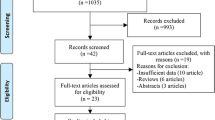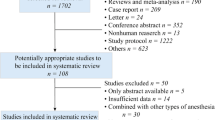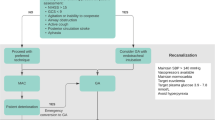Abstract
Purpose
Endovascular treatment for stroke patients usually requires anesthesia care, with no current consensus on the best anesthetic management strategy. Several randomized controlled trials and meta-analyses have attempted to address this. In 2022, additional evidence from three new trials was published: the GASS trial, the CANVAS II trial, and preliminary results from the AMETIS trial, prompting the execution of this updated systematic review and meta-analysis. The primary objective of this study was to evaluate the effects of general anesthesia and conscious sedation on functional outcomes measured with the modified Rankin scale (mRS) at three months.
Methods
We performed a systematic review and meta-analysis of randomized controlled trials investigating conscious sedation and general anesthesia in endovascular treatment. The following databases were examined: PubMed, Scopus, Embase, and the Cochrane Database of Randomized Controlled Trials and Systematic Reviews. The Risk of Bias 2 tool was used to assess bias. In addition, trial sequence analysis was performed on the primary outcome to estimate if the cumulative effect is significant enough to be unaffected by further studies.
Results
Nine randomized controlled trials were identified, including 1,342 patients undergoing endovascular treatment for stroke. No significant differences were detected between general anesthesia and conscious sedation with regards to mRS, functional independence (mRS, 0–2), procedure duration, onset to reperfusion, mortality, hospital length of stay, and intensive care unit length of stay. Patients treated under general anesthesia may have more frequent successful reperfusion, though the time from groin to reperfusion was slightly longer. Trial sequential analysis showed that additional trials are unlikely to show marked differences in mean mRS at three months.
Conclusions
In this updated systematic review and meta-analysis, the choice of anesthetic strategy for endovascular treatment of stroke patients did not significantly impact functional outcome as measured with the mRS at three months. Patients managed with general anesthesia may have more frequent successful reperfusion.
Trial registration
PROSPERO (CRD42022319368); registered 19 April 2022.
Résumé
Objectif
Le traitement endovasculaire pour les patient·es victimes d’un accident vasculaire cérébral (AVC) nécessite généralement des soins d’anesthésie, mais il n’existe actuellement aucun consensus sur la meilleure stratégie de prise en charge anesthésique. Plusieurs études randomisées contrôlées et méta-analyses ont tenté d’aborder cette question. En 2022, des données probantes supplémentaires provenant de trois nouvelles études ont été publiées : l’étude GASS, l’étude CANVAS II et les résultats préliminaires de l’étude AMETIS, ce qui a motivé la réalisation de cette revue systématique et méta-analyse mises à jour. L’objectif principal de cette étude était d’évaluer les effets de l’anesthésie générale et de la sédation consciente sur les devenirs fonctionnels mesurés avec l’échelle de Rankin modifiée (mRS) à trois mois.
Méthode
Nous avons réalisé une revue systématique avec méta-analyse d’études randomisées contrôlées portant sur la sédation consciente et l’anesthésie générale dans le traitement endovasculaire. Les bases de données suivantes ont été examinées : PubMed, Scopus, Embase et la base de données Cochrane des études randomisées contrôlées et des revues systématiques. L’outil Risque de biais 2 a été utilisé pour évaluer le biais. De plus, une analyse séquentielle des études a été effectuée sur le critère d’évaluation principal afin d’estimer si l’effet cumulatif était suffisamment significatif pour ne pas être affecté par d’autres études.
Résultats
Neuf études randomisées contrôlées ont été identifiées, incluant 1342 patient·es bénéficiant d’un traitement endovasculaire pour un AVC. Aucune différence significative n’a été détectée entre l’anesthésie générale et la sédation consciente en ce qui concerne la mRS, l’indépendance fonctionnelle (mRS, 0-2), la durée de l’intervention, le moment d’apparition de la reperfusion, la mortalité, la durée de séjour à l’hôpital et la durée de séjour en unité de soins intensifs. Les patient·es traité·es sous anesthésie générale pourraient avoir une reperfusion réussie plus fréquente, bien que le temps entre l’aine et la reperfusion était légèrement plus long. L’analyse séquentielle des études a montré qu’il est peu probable que d’autres études montrent des différences marquées dans la mRS moyenne à trois mois.
Conclusion
Dans cette revue systématique et méta-analyse mises à jour, le choix de la stratégie anesthésique pour le traitement endovasculaire des personnes victimes d’un AVC n’a pas eu d’impact significatif sur les devenirs fonctionnels mesurés avec la mRS à trois mois. La réussite de la reperfusion pourrait être plus fréquente chez les patient·es pris·es en charge par anesthésie générale.
Enregistrement de l’étude
PROSPERO (CRD42022319368); enregistrée le 19 avril 2022.




Similar content being viewed by others
References
World Health Organization. Global health estimates: life expectancy and leading causes of death and disability, 2022. Available from URL: https://www.who.int/data/gho/data/themes/mortality-and-global-health-estimates (accessed December 2022).
Dornbos D 3rd, Arthur AS. Current state of the art in endovascular stroke treatment. Neurol Clin 2022; 40: 309–19. https://doi.org/10.1016/j.ncl.2021.11.008
American Society of Anesthesiologists’. Continuum of depth of sedation: definition of general anesthesia and levels of sedation/analgesia, 2019. Available from URL: https://www.asahq.org/standards-and-guidelines/continuum-of-depth-of-sedation-definition-of-general-anesthesia-and-levels-of-sedationanalgesia (accessed December 2022).
Bai X, Zhang X, Wang T, et al. General anesthesia versus conscious sedation for endovascular therapy in acute ischemic stroke: a systematic review and meta-analysis. J Clin Neurosci 2021; 86: 10–7. https://doi.org/10.1016/j.jocn.2021.01.012
Campbell D, Diprose WK, Deng C, Barber PA. General anesthesia versus conscious sedation in endovascular thrombectomy for stroke: a meta-analysis of 4 randomized controlled trials. J Neurosurg Anesthesiol 2021; 33: 21–7. https://doi.org/10.1097/ana.0000000000000646
Schönenberger S, Hendén PL, Simonsen CZ, et al. Association of general anesthesia vs procedural sedation with functional outcome among patients with acute ischemic stroke undergoing thrombectomy: a systematic review and meta-analysis. JAMA 2019; 322: 1283–93. https://doi.org/10.1001/jama.2019.11455
Zhang Y, Jia L, Fang F, Ma L, Cai B, Faramand A. General anesthesia versus conscious sedation for intracranial mechanical thrombectomy: a systematic review and meta-analysis of randomized clinical trials. J Am Heart Assoc 2019; 8: e011754. https://doi.org/10.1161/jaha.118.011754
Lee CW, Chang YP, Huang YT, et al. General anesthesia but not conscious sedation improves functional outcome in patients receiving endovascular thrombectomy for acute ischemic stroke: a meta-analysis of randomized clinical trials and trial sequence analysis. Front Neurol 2022; 13: 1017098. https://doi.org/10.3389/fneur.2022.1017098
Campbell D, Butler E, Barber PA. End the confusion: general anaesthesia improves patient outcomes in endovascular thrombectomy. Br J Anaesth 2022; 129: 461–4. https://doi.org/10.1016/j.bja.2022.06.018
Maurice A, Eugène F, Ronzière T, et al. General anesthesia versus sedation, both with hemodynamic control, during intraarterial treatment for stroke: the GASS randomized trial. Anesthesiology 2022; 136: 567–76. https://doi.org/10.1097/aln.0000000000004142
Chabanne R, Geeraerts T, Begard M, et al. Procedural sedation versus general anesthesia in anterior circulation large vessel occlusion thrombectomy: the Anesthesia Management in Endovascular Therapy for Ischemic Stroke (AMETIS) randomized controlled trial (conference abstract). Eur Stroke J 2022; 7: 3–545. https://doi.org/10.1177/23969873221087559
Liang F, Wu Y, Wang X, et al. General anesthesia vs conscious sedation for endovascular treatment in patients with posterior circulation acute ischemic stroke: an exploratory randomized clinical trial. JAMA Neurol 2022; e223018. https://doi.org/10.1001/jamaneurol.2022.3018
Liberati A, Altman DG, Tetzlaff J, et al. The PRISMA statement for reporting systematic reviews and meta-analyses of studies that evaluate healthcare interventions: explanation and elaboration. BMJ 2009; 339: b2700. https://doi.org/10.1136/bmj.b2700
Sterne JA, Savović J, Page MJ, et al. RoB 2: a revised tool for assessing risk of bias in randomised trials. BMJ 2019; 366: l4898. https://doi.org/10.1136/bmj.l4898
Guyatt GH, Oxman AD, Vist GE, et al. GRADE: an emerging consensus on rating quality of evidence and strength of recommendations. BMJ 2008; 336: 924–6. https://doi.org/10.1136/bmj.39489.470347.ad
Hozo SP, Djulbegovic B, Hozo I. Estimating the mean and variance from the median, range, and the size of a sample. BMC Med Res Methodol 2005; 5: 13. https://doi.org/10.1186/1471-2288-5-13
Cumpston M, Li T, Page MJ, et al. Updated guidance for trusted systematic reviews: a new edition of the Cochrane Handbook for Systematic Reviews of Interventions. Cochrane Database Syst Rev 2019; 10: ED000142. https://doi.org/10.1002/14651858.ed000142
Röver C, Knapp G, Friede T. Hartung-Knapp-Sidik-Jonkman approach and its modification for random-effects meta-analysis with few studies. BMC Med Res Methodol 2015; 15: 99. https://doi.org/10.1186/s12874-015-0091-1
IntHout J, Ioannidis JP, Borm GF. The Hartung-Knapp-Sidik-Jonkman method for random effects meta-analysis is straightforward and considerably outperforms the standard DerSimonian-Laird method. BMC Med Res Methodol 2014; 14: 25. https://doi.org/10.1186/1471-2288-14-25
Schwarzer G, Carpenter JR, Rucker G. Meta-Analysis with R, 1st ed. Cham: Springer International Publishing; 2015.
Veroniki AA, Jackson D, Viechtbauer W, et al. Methods to estimate the between‐study variance and its uncertainty in meta‐analysis. Res Synth Methods 2016; 7: 55–79. https://doi.org/10.1002/jrsm.1164
De Cassai A, Pasin L, Boscolo A, Salvago M, Navalesi P. Trial sequential analysis: plain and simple. Korean J Anesthesiol 2021; 74: 363–5. https://doi.org/10.4097/kja.20637
Broderick JP, Adeoye O, Elm J. Evolution of the modified Rankin scale and its use in future stroke trials. Stroke 2017; 48: 2007–12. https://doi.org/10.1161/strokeaha.117.017866
Bath PM, Lees KR, Schellinger PD, et al. Statistical analysis of the primary outcome in acute stroke trials. Stroke 2012; 43: 1171–8. https://doi.org/10.1161/strokeaha.111.641456
Löwhagen Hendén P, Rentzos A, Karlsson JE, et al. General anesthesia versus conscious sedation for endovascular treatment of acute ischemic stroke: the AnStroke trial (anesthesia during stroke). Stroke 2017; 48: 1601–7. https://doi.org/10.1161/strokeaha.117.016554
Schönenberger S, Uhlmann L, Hacke W, et al. Effect of conscious sedation vs general anesthesia on early neurological improvement among patients with ischemic stroke undergoing endovascular thrombectomy: a randomized clinical trial. JAMA 2016; 316: 1986–96. https://doi.org/10.1001/jama.2016.16623
Simonsen CZ, Yoo AJ, Sørensen LH, et al. Effect of general anesthesia and conscious sedation during endovascular therapy on infarct growth and clinical outcomes in acute ischemic stroke: a randomized clinical trial. JAMA Neurol 2018; 75: 470–7. https://doi.org/10.1001/jamaneurol.2017.4474
Sun J, Liang F, Wu Y, et al. Choice of Anesthesia for EndoVAScular treatment of acute ischemic stroke (CANVAS): results of the CANVAS pilot randomized controlled trial. J Neurosurg Anesthesiol 2020; 32: 41–7. https://doi.org/10.1097/ana.0000000000000567
Ren C, Xu G, Liu Y, Liu G, Wang J, Gao J. Effect of conscious sedation vs. general anesthesia on outcomes in patients undergoing mechanical thrombectomy for acute ischemic stroke: a prospective randomized clinical trial. Front Neurol 2020; 11: 170. https://doi.org/10.3389/fneur.2020.00170
Hu G, Shi Z, Li B, Shao W, Xu B. General anesthesia versus monitored anesthesia care during endovascular therapy for vertebrobasilar stroke. Am J Transl Res 2021; 13: 1558–67.
Powers WJ, Rabinstein AA, Ackerson T, et al. Guidelines for the early management of patients with acute ischemic stroke: 2019 update to the 2018 guidelines for the early management of acute ischemic stroke: a guideline for healthcare professionals from the American Heart Association/American Stroke Association. Stroke 2019; 50: e344–418. https://doi.org/10.1161/str.0000000000000211
Tosello R, Riera R, Tosello G, et al. Type of anaesthesia for acute ischaemic stroke endovascular treatment. Cochrane Database Syst Rev 2022; 7: CD013690. https://doi.org/10.1002/14651858.cd013690.pub2
Brinjikji W, Murad MH, Rabinstein AA, Cloft HJ, Lanzino G, Kallmes DF. Conscious sedation versus general anesthesia during endovascular acute ischemic stroke treatment: a systematic review and meta-analysis. AJNR Am J Neuroradiol 2015; 36: 525–9. https://doi.org/10.3174/ajnr.a4159
Brinjikji W, Pasternak J, Murad MH, et al. Anesthesia-related outcomes for endovascular stroke revascularization: a systematic review and meta-analysis. Stroke 2017; 48: 2784–91. https://doi.org/10.1161/strokeaha.117.017786
Butt W, Dhillon PS, Podlasek A, et al. Local anesthesia as a distinct comparator versus conscious sedation and general anesthesia in endovascular stroke treatment: a systematic review and meta-analysis. J Neurointerv Surg 2022; 14: 221–6. https://doi.org/10.1136/neurintsurg-2021-017360
Ilyas A, Chen C-J, Ding D, et al. Endovascular mechanical thrombectomy for acute ischemic stroke under general anesthesia versus conscious sedation: a systematic review and meta-analysis. World Neurosurg 2018; 112: e355–67. https://doi.org/10.1016/j.wneu.2018.01.049
Jing R, Dai HJ, Lin F, Ge WY, Pan LH. Conscious sedation versus general anesthesia for patients with acute ischemic stroke undergoing endovascular therapy: a systematic review and meta-analysis. Biomed Res Int 2018; 2018: 1–9. https://doi.org/10.1155/2018/2318489
Wan TF, Zhang JR, Liu L. Effect of general anesthesia vs. conscious sedation on the outcomes of acute ischemic stroke patients after endovascular therapy: a meta-analysis of randomized clinical trials. Front Neurol 2019; 10: 1131. https://doi.org/10.3389/fneur.2019.01131
Gravel G, Boulouis G, Benhassen W, et al. Anaesthetic management during intracranial mechanical thrombectomy: systematic review and meta-analysis of current data. J Neurol Neurosurg Psychiatry 2019; 90: 68–74. https://doi.org/10.1136/jnnp-2018-318549
Kim C, Kim SE, Jeon JP. Influence of anesthesia type on outcomes after endovascular treatment in acute ischemic stroke: meta-analysis. Neurointervention 2019; 14: 17–26. https://doi.org/10.5469/neuroint.2019.00045
Li X, Hu Z, Li Q, et al. Anesthesia for endovascular treatment in anterior circulation stroke: a systematic review and meta-analysis. Brain Behav 2019; 9: e01178. https://doi.org/10.1002/brb3.1178
Shen H, Ma X, Wu Z, et al. Conscious sedation compared to general anesthesia for intracranial mechanical thrombectomy: a meta-analysis. Brain Behav 2021; 11: e02161. https://doi.org/10.1002/brb3.2161
Feil K, Herzberg M, Dorn F, et al. General anesthesia versus conscious sedation in mechanical thrombectomy. J Stroke 2021; 23: 103–12. https://doi.org/10.5853/jos.2020.02404
Cappellari M, Pracucci G, Forlivesi S, et al. General anesthesia versus conscious sedation and local anesthesia during thrombectomy for acute ischemic stroke. Stroke 2020; 51: 2036–44. https://doi.org/10.1161/strokeaha.120.028963
Dhillon PS, Butt W, Podlasek A, et al. Association between anesthesia modality and clinical outcomes following endovascular stroke treatment in the extended time window. J Neurointerv Surg 2022; https://doi.org/10.1136/neurintsurg-2022-018846
Han H, Wang Y, Wang H, et al. General anesthesia vs. local anesthesia during endovascular treatment for acute large vessel occlusion: a propensity score-matched analysis. Front Neurol 2022; 12: 801024. https://doi.org/10.3389/fneur.2021.801024
Simonsen CZ, Schönenberger S, Hendén PL, et al. Patients requiring conversion to general anesthesia during endovascular therapy have worse outcomes: a post hoc analysis of data from the SAGA collaboration. AJNR Am J Neuroradiol 2020; 41: 2298–302. https://doi.org/10.3174/ajnr.a6823
Geraldini F, De Cassai A, Napoli M, et al. Risk factors for general anesthesia conversion in anterior circulation stroke patients undergoing endovascular treatment. Cerebrovasc Dis 2021; 51: 481–7. https://doi.org/10.1159/000520929
Chen M, Kronsteiner D, Pfaff JA, et al. Emergency intubation during thrombectomy for acute ischemic stroke in patients under primary procedural sedation. Neurol Res Pract 2021; 3: 27. https://doi.org/10.1186/s42466-021-00125-0
Manning NW, Warne CD, Meyers PM. Reperfusion and clinical outcomes in acute ischemic stroke: systematic review and meta-analysis of the Stent-retriever-based, early window endovascular stroke trials. Front Neurol 2018; 9: 301. https://doi.org/10.3389/fneur.2018.00301
Lee SH, Kim BJ, Han MK, et al. Futile reperfusion and predicted therapeutic benefits after successful endovascular treatment according to initial stroke severity. BMC Neurol 2019; 19: 11. https://doi.org/10.1186/s12883-019-1237-2
Hindman BJ, Dexter F. Anesthetic management of emergency endovascular thrombectomy for acute ischemic stroke, part 2: integrating and applying observational reports and randomized clinical trials. Anesth Analg 2019; 128: 706–17.
Author contributions
Federico Geraldini conceived the idea, performed the initial search, contacted corresponding authors for missing data, performed the statistical analysis, and wrote and edited the manuscript. Paolo Diana conceived the idea, manually reviewed and assessed each of the included studies, and wrote and edited the manuscript. Davide Fregolent reviewed titles, abstracts, and full text manuscripts for potential inclusion and wrote and edited the manuscript. Alessandro De Cassai helped with the statistical evaluation, performed the ROB2 evaluation, and wrote and edited the manuscript. Annalisa Boscolo performed the ROB 2 evaluation and wrote and edited the manuscript. Tommaso Pettenuzzo performed the GRADE assessment, manually reviewed and assessed each of the included studies, and wrote and edited the manuscript. Nicolò Sella screened for duplicates, supervised the ROB 2 evaluation, resolving disputes, and helped with the revision and editing of the manuscript. Irene Lupelli reviewed titles, abstracts, and full text manuscripts for potential inclusion and critically revised and edited the manuscript. Paolo Navalesi supervised the project, helped with the interpretation and contextualization of the results, and critically assessed and edited the finalized manuscript. Marina Munari helped plan the research, assessed it for overall merit, supervised the project, helped with the interpretation and contextualization of the results, and critically assessed and edited the finalized manuscript.
Disclosures
All authors have no conflict of interest to report.
Funding statement
No funding to declare.
Editorial responsibility
This submission was handled by Dr. Stephan K. W. Schwarz, Editor-in-Chief, Canadian Journal of Anesthesia/Journal canadien d’anesthésie.
Author information
Authors and Affiliations
Additional information
Publisher's Note
Springer Nature remains neutral with regard to jurisdictional claims in published maps and institutional affiliations.
Supplementary Information
Below is the link to the electronic supplementary material.
Rights and permissions
Springer Nature or its licensor (e.g. a society or other partner) holds exclusive rights to this article under a publishing agreement with the author(s) or other rightsholder(s); author self-archiving of the accepted manuscript version of this article is solely governed by the terms of such publishing agreement and applicable law.
About this article
Cite this article
Geraldini, F., Diana, P., Fregolent, D. et al. General anesthesia or conscious sedation for thrombectomy in stroke patients: an updated systematic review and meta-analysis. Can J Anesth/J Can Anesth 70, 1167–1181 (2023). https://doi.org/10.1007/s12630-023-02481-8
Received:
Revised:
Accepted:
Published:
Issue Date:
DOI: https://doi.org/10.1007/s12630-023-02481-8




